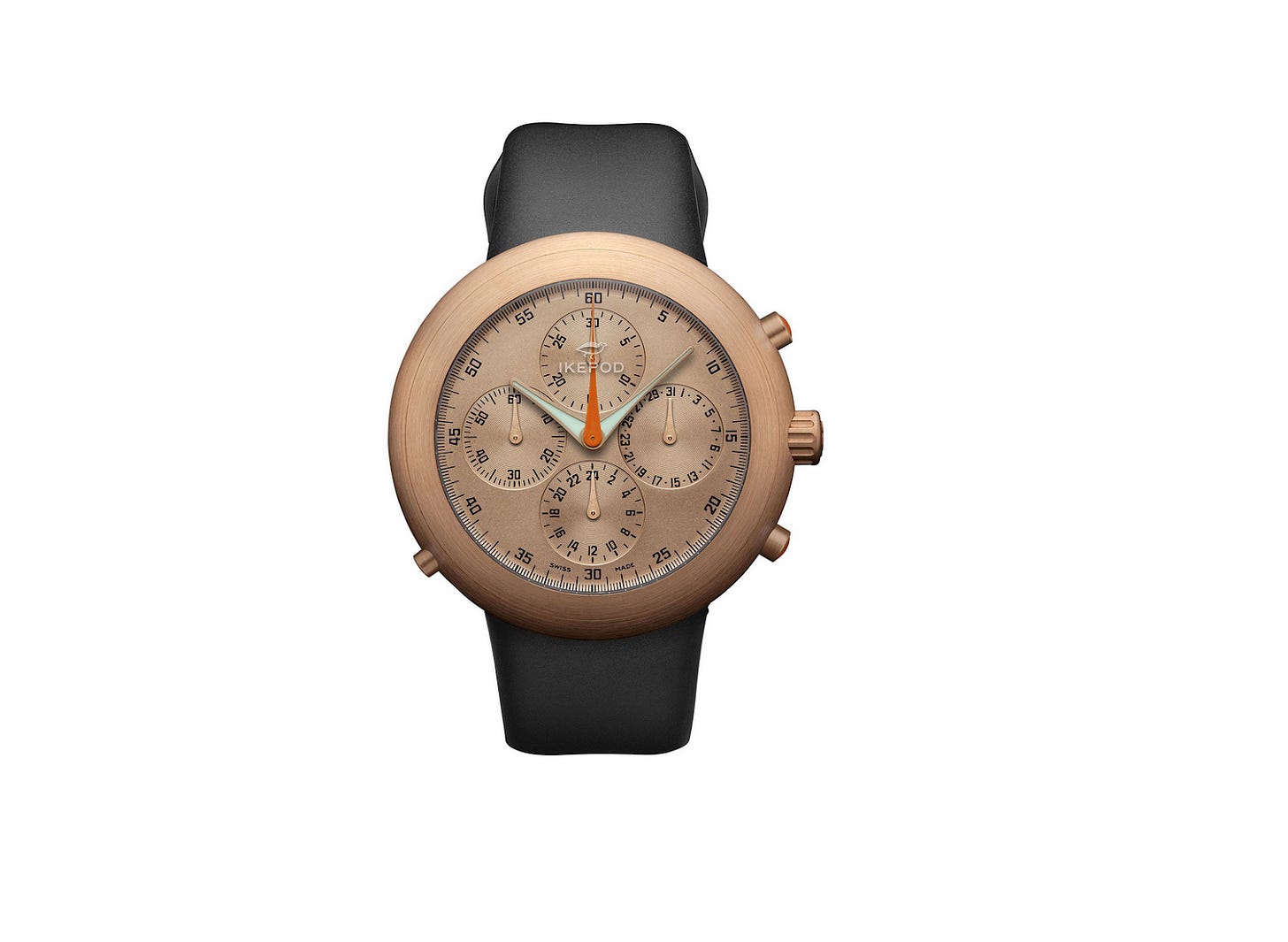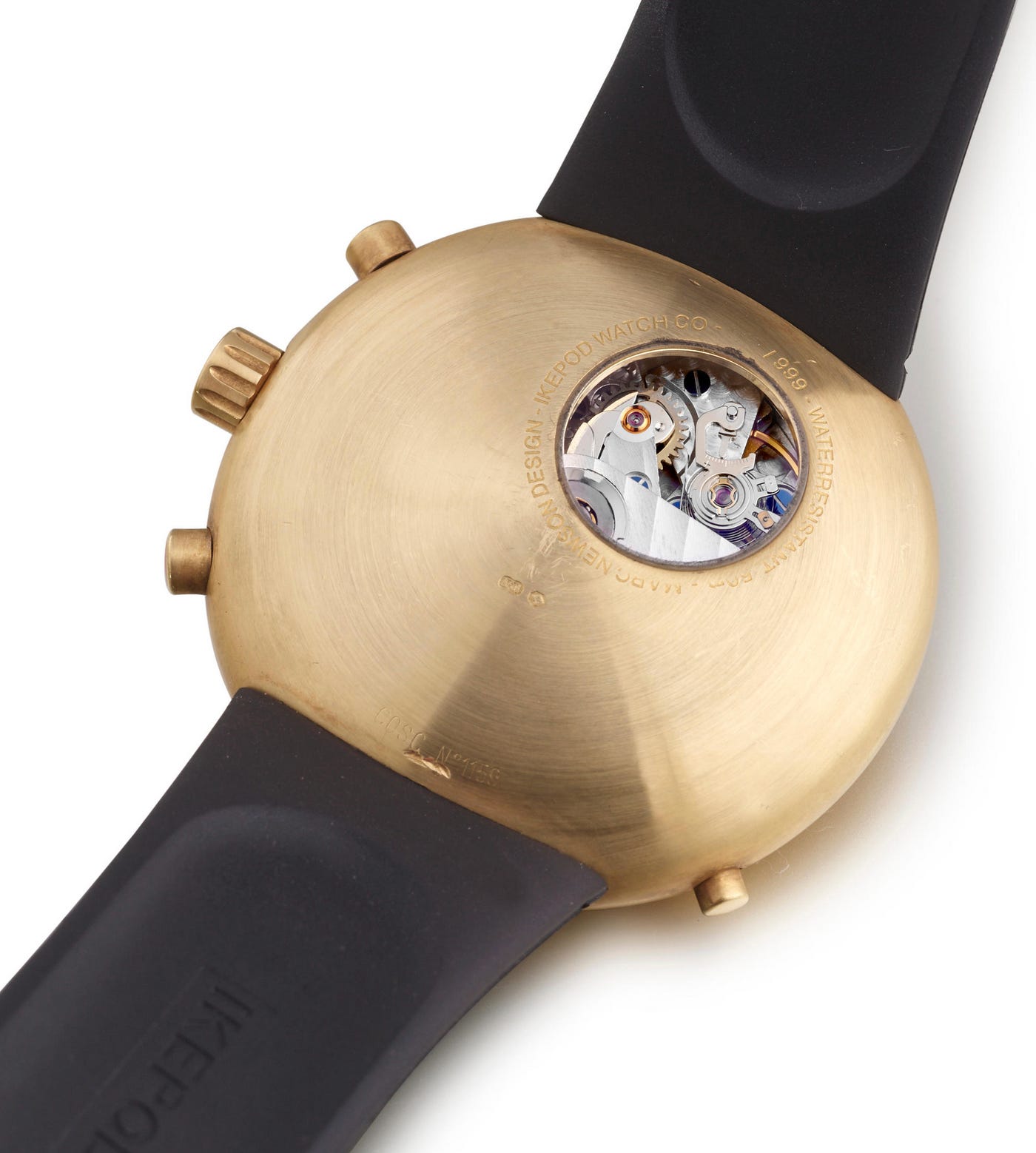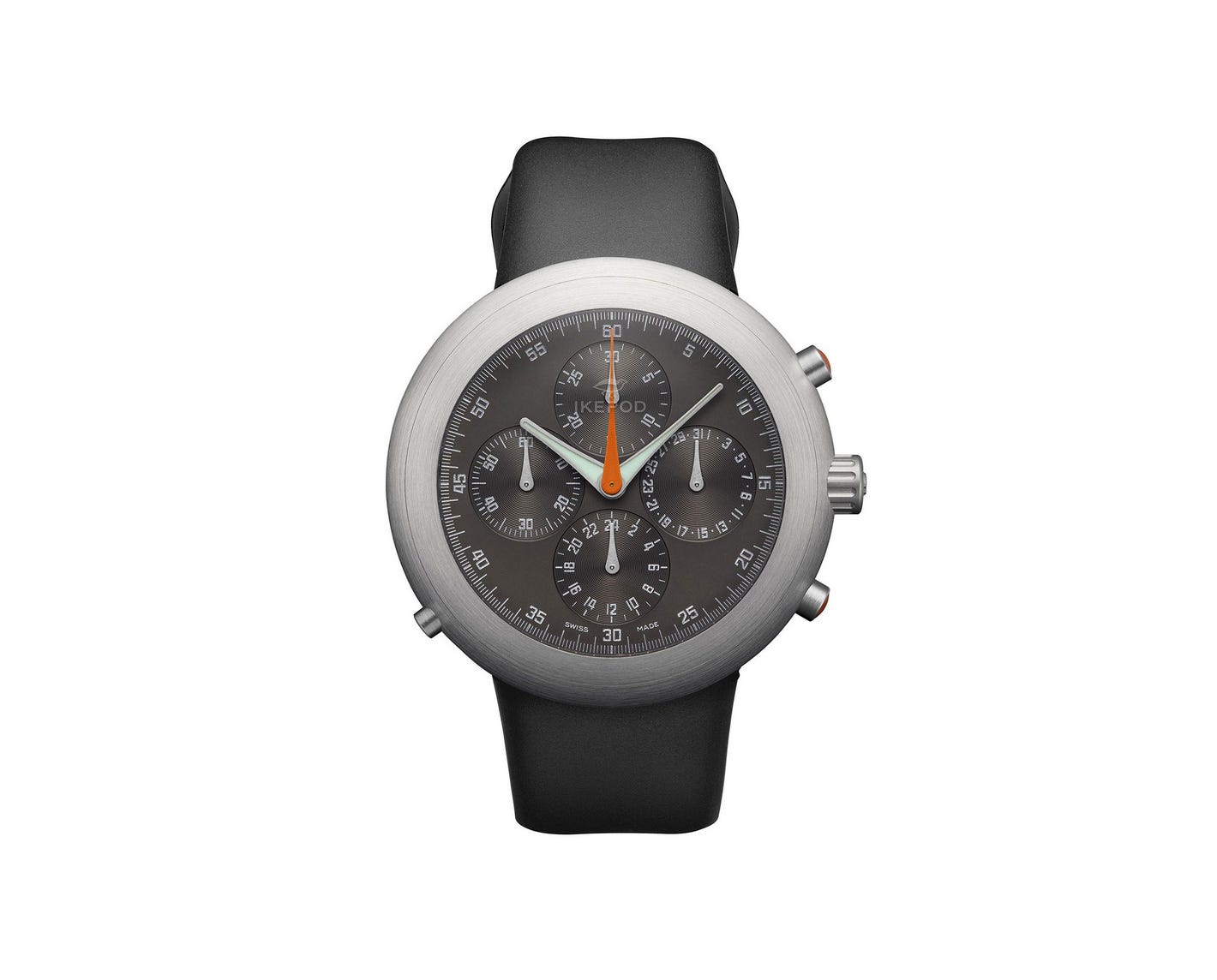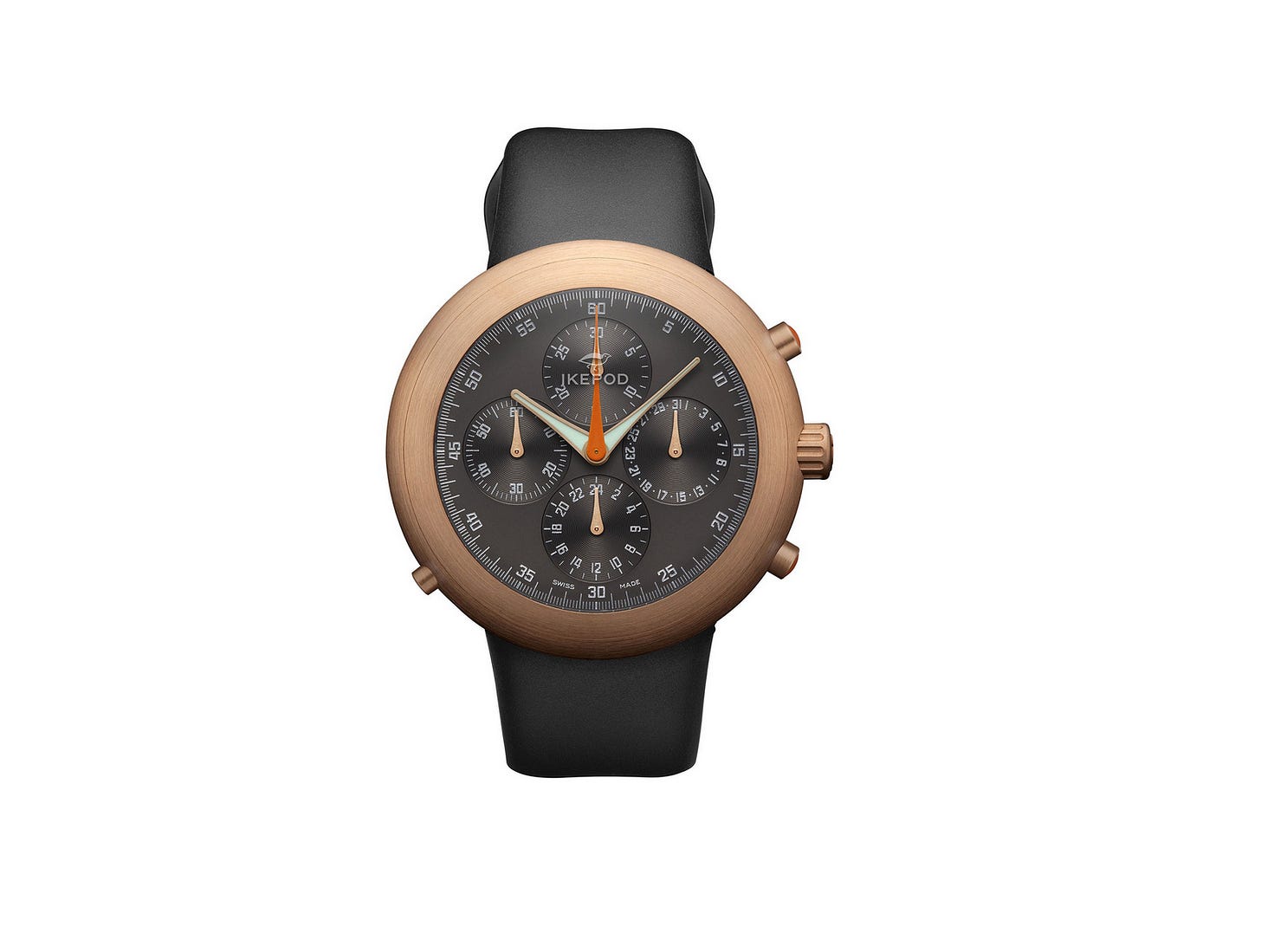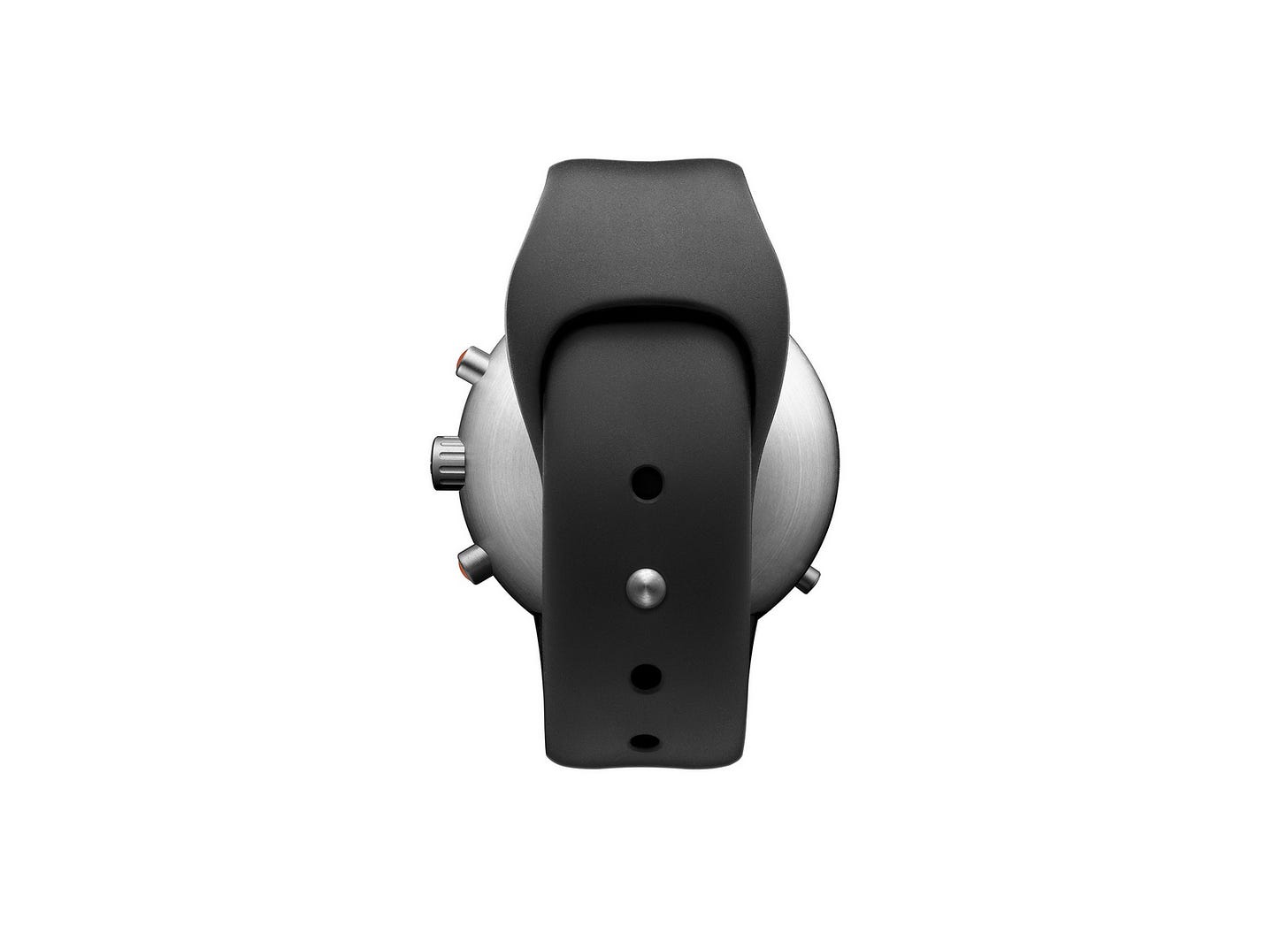The Ikepod Hemipode Paradox: A Cultural Archaeology
When Radical Design Outpaces Its Era.
There exists, in the taxonomy of overlooked design objects, a certain species of artifact that inhabits the uncanny valley between commercial failure and cultural prescience. The Ikepod Hemipode of 1998 occupies this liminal space with particular grace—a 44mm chronograph that somehow managed to predict the aesthetic preoccupations of the next quarter-century while remaining commercially invisible to all but a narrow stratum of design cognoscenti.
Marc Newson's hemispheric watch emerges from the DOSSIER framework as something approaching a perfect specimen of misdirected genius. Its design distinction operates on multiple registers: the monocoque case construction that achieves what Newson termed "geometric purity," the flush crystal creating an unbroken ellipse, the off-center caseback window that serves no functional purpose beyond asserting the primacy of form. These were not merely stylistic choices but philosophical statements about the nature of objects in space—statements that would prove remarkably durable as design culture evolved toward minimalism and material honesty.
The origin context reveals the Hemipode as a creature fundamentally misaligned with its moment. Released during the final throes of the quartz crisis, when the Swiss industry was still recovering its confidence and 38mm cases represented the outer limit of respectability, Newson's 44mm ellipse appeared almost alien. The watch launched at $10,000 in gold—twice the price of a contemporary Submariner—for what was essentially an ETA 7750 movement wrapped in industrial design theory. The market was unprepared for a product that positioned itself as luxury goods through design rather than heritage, manufacturing complexity, or precious materials alone.
Yet the signature innovations embedded within the Hemipode read today like a catalog of subsequently validated design principles. The integrated rubber strap that flows seamlessly into the case prefigures the Apple Watch Sport Band by nearly two decades. The monobloc construction eliminates traditional lugs in favor of what Newson called "unity of form and function"—a phrase that could have been lifted from Jonathan Ive's design philosophy. The emphasis on symmetrical dial layouts, achieved through custom movement modifications, anticipates the obsessive balance that would later define contemporary minimalist design.
Most tellingly, the Hemipode's subcultural relevance began precisely where traditional watch collecting ended. While horologists dismissed it as an overpriced curiosity, the piece found its audience among industrial designers, architects, and what might be termed the "techno-minimalist" movement of the late 1990s. Robin Williams owned one. Kanye West reportedly called it his favorite watch. These adoption patterns suggest a different kind of cultural transmission—one that bypassed traditional luxury channels entirely and operated through networks of design influence and aesthetic philosophy.
The identity clarity of the piece remains its most remarkable achievement. Where other design watches of the era often felt tentative or compromised, the Hemipode possessed what can only be described as conviction. It was unmistakably itself: neither apologetic about its unconventional proportions nor attempting to mimic traditional horological grammar. This confidence would prove prophetic as the watch industry gradually embraced larger cases, integrated bracelets, and the elevation of design as a primary value proposition.
Assessing the endurance potential requires acknowledging that the Hemipode has already survived its first test of time. Twenty-five years after its introduction, examples trade for significant premiums over their original retail prices—not merely as vintage curiosities but as recognized design artifacts. The aesthetic principles it embodied have become so thoroughly absorbed into contemporary design culture that pieces like the Apple Watch now appear as natural evolutions rather than radical departures.
The rarity with reason criterion reveals perhaps the most interesting aspect of the Hemipode's trajectory. Production was limited not by marketing artifice but by manufacturing complexity. The smooth, flowing surfaces that Newson demanded required CNC technology at the very edge of its 1990s capabilities. The flush integration of disparate materials and the seamless marriage of case and strap pushed Swiss manufacturing tolerances to their limits. This technical difficulty, combined with the piece's commercial non-viability, created what the DOSSIER framework terms "accidental collectibility"—scarcity driven by authentic production constraints rather than manufactured exclusivity.
The Hemipode ultimately scores high across six of the seven DOSSIER criteria, marking it as precisely the kind of overlooked cultural artifact that serious collectors should recognize. Yet its story reveals something more complex than mere market inefficiency. The piece exists as evidence of design culture's non-linear progression—a reminder that innovation often precedes acceptance by decades, and that the objects we dismiss as commercial failures may be the very artifacts that define aesthetic discourse generations later.
In this light, the Hemipode functions less as a watch than as a cultural diagnostic—a device for measuring the distance between innovation and acceptance, between design vision and market reality. Its current status as a sought-after collector's piece represents not redemption but vindication: proof that certain objects carry within themselves the seeds of their own eventual recognition, waiting patiently for culture to catch up with their propositions.
Bibliography
Adams, Ariel. "10 Interesting Facts About Marc Newson's Watch Design Work At Ikepod." aBlogtoWatch, November 19, 2024. https://www.ablogtowatch.com/10-interesting-facts-marc-newson-watch-design-work-ikepod/.
Fairs, Marcus. "Ikepod wristwatches by Marc Newson." Dezeen, December 10, 2007. https://www.dezeen.com/2007/12/10/ikepod-wristwatches-by-marc-newson/.
Green, Martin. "Ikepod Megapode: Marc Newson's Smartest Watch (And Perhaps My Smartest Rolex Trade)." Quill & Pad, July 1, 2024. https://quillandpad.com/2018/04/18/ikepod-megapode-marc-newsons-smartest-watch-and-perhaps-my-smartest-rolex-trade/.
Ikepod. "Ikepod® Watches - same Design, New price." Accessed June 16, 2025. https://ikepod.com/en/.
Newson, Marc. "Hemipode Watch." Marc Newson Ltd. Accessed June 16, 2025. https://marc-newson.com/hemipode-watch/.
Traina, Anthony. "In-Depth: Marc Newson Opens Up About Ikepod, The Pathbreaking '90s Watch Brand That's Cool All Over Again." HODINKEE, November 26, 2022. https://www.hodinkee.com/articles/marc-newson-opens-up-about-ikepod-the-pathbreaking-90s-watch-brand-thats-cool-all-over-again.
Traina, Anthony. "Ikepod: Design and the Art of Time." A Collected Man, October 21, 2021. https://www.acollectedman.com/blogs/journal/ikepod-design.
Uncrate. "Ikepod Hemipode Chronograph Watch." June 12, 2021. https://uncrate.com/ikepod-hemipode-chronograph-watch/.
Weppeling, Jorg. "Dear Ikepod, Bring Back The Hemipode." Fratello Watches, May 29, 2022. https://www.fratellowatches.com/dear-ikepod-bring-back-the-hemipode/.
About the Author
Sergio Galanti is a journalist specializing in independent watchmaking and mechanical horology.



